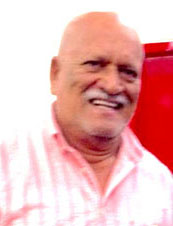The name Beni Sankar still remains inextricably linked to the country’s rice industry. But the 68-year-old farmer says openly that he has closed the door on the sector which, over the years, has made the Sankar name a household one in local business circles.
“I’m too old for that now,” Sankar says, though, still seemingly full of entrepreneurial spirit you get a sense that his pragmatism will take him wherever worthwhile business opportunities might call.
He is inclined to take his time guiding you through the peaks and troughs of the Sankar experience in the rice industry, from the big investment risks that saw his father Kayman rise to become the country’s most successful rice farmer, to the decline of the Sankar rice empire, a circumstance which he attributes, at least in part, to the machinations of local politics.
When you eventually raise the question about the likelihood of a future in rice, his answer is definitive but without the profundity that compels you to believe him. “Rice is risky,” he says. “You can get big returns but it can be risky. No more rice for me; except for eating it, of course.”

The odd thing about his answer is the conflicting rejoinder that follows. “As far as I am concerned rice farmers are making money,” he says. “The problem is not a rice industry problem it’s a social problem. If a man does not have 20 acres of rice land he is unlikely to make the minimum wage. It makes no sense in blaming the millers. Farmers with small acreages must begin to diversify. Those guys who have 20 acres and more make money. It’s mechanical. Lands are ploughed and prepared, the rice is sewn, the paddy is delivered and they collect their cheques from the millers. It is the smaller guys that have the struggles.”
Sankar is not convinced that the now abandoned PetroCaribe deal under which Guyana, among other Caricom countries, secured a preferential market for paddy in Venezuela was necessarily good for the local rice industry. “Venezuela was only buying about one third of our production at a high price and the question arises as to what you do with the other two thirds. The problem was that all of the rice farmers wanted the same price for their paddy as the price for which Venezuela was buying it.” He goes further, asserting that traditional Caribbean markets are now “securing rice from other sources. If we were still in the market and supplying them we would not have had that problem. We could have done without PetroCaribe,” Sankar says.
“Guyana is in a unique situation. Only four per cent of the 400 million tonnes of rice being produced globally is being traded. Guyana is trading 75 per cent of its production. What that means, obviously, is that the Guyana Rice Development Board needs to go looking for markets. The big millers are doing just that. Of course a lot of money came from PetroCaribe. Once our rice went there we got good prices for our paddy. The problem as I said is that the farmers were still demanding the same price for paddy not sold to Venezuela.”
Sankar returns to the theme of diversification. “If a man has five acres of land he might consider in these times putting an acre into fish ponds and other portions into vegetables, chicken and ducks. That way he is going to be employed all year around. I don’t expect that all rice farmers will respond to the diversification call but what I am hoping is that those who do will set an example for the others,” he says.
If diversification is to work, Sankar says, there will have to be “serious adjustments in other areas of the agricultural support infrastructure. He says that with the level of diversification that might occur the state agencies like the Guyana Marketing Corporation, Guyana Livestock Development Authority and the National Agriculture Research and Extension Institute must step up in terms of providing extension services and marketing support for diversification. “These entities have got to go out into the fields and support the diversification initiative. There will also have to be marketing initiatives to support the production levels in areas like milk and meat that could come from diversification.”
Sankar believes he has led the diversification call by example. At Hampton Court on the Essequibo Coast his farming pursuits have taken him into fish cultivation, goats and more recently, through a Hampton Court-based company named Guyana Ideal Life Inc, a line of coconut by-products, including the globally popular virgin coconut oil. That, it would seem, is his current primary preoccupation, his focus being on product refinement, overseas markets and packaging.
Going forward, Sankar says, Guyana Ideal Life will be providing an expanded market for coconuts on the Essequibo Coast. He says too that he is beginning to create a niche for coconut oil on the Miami market. “We are losing money on the market at this time but we have an undertaking that the price will be negotiated after six months. So we have agreed to go with it. I am also doing coconut flour now,” he says.
“I have always been a farmer. I believe that my experience makes me an example. I have experience across several sectors and I believe that there is much that has happened to me from which other farmers can learn.”





